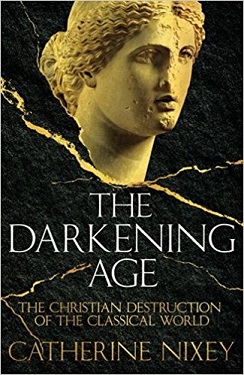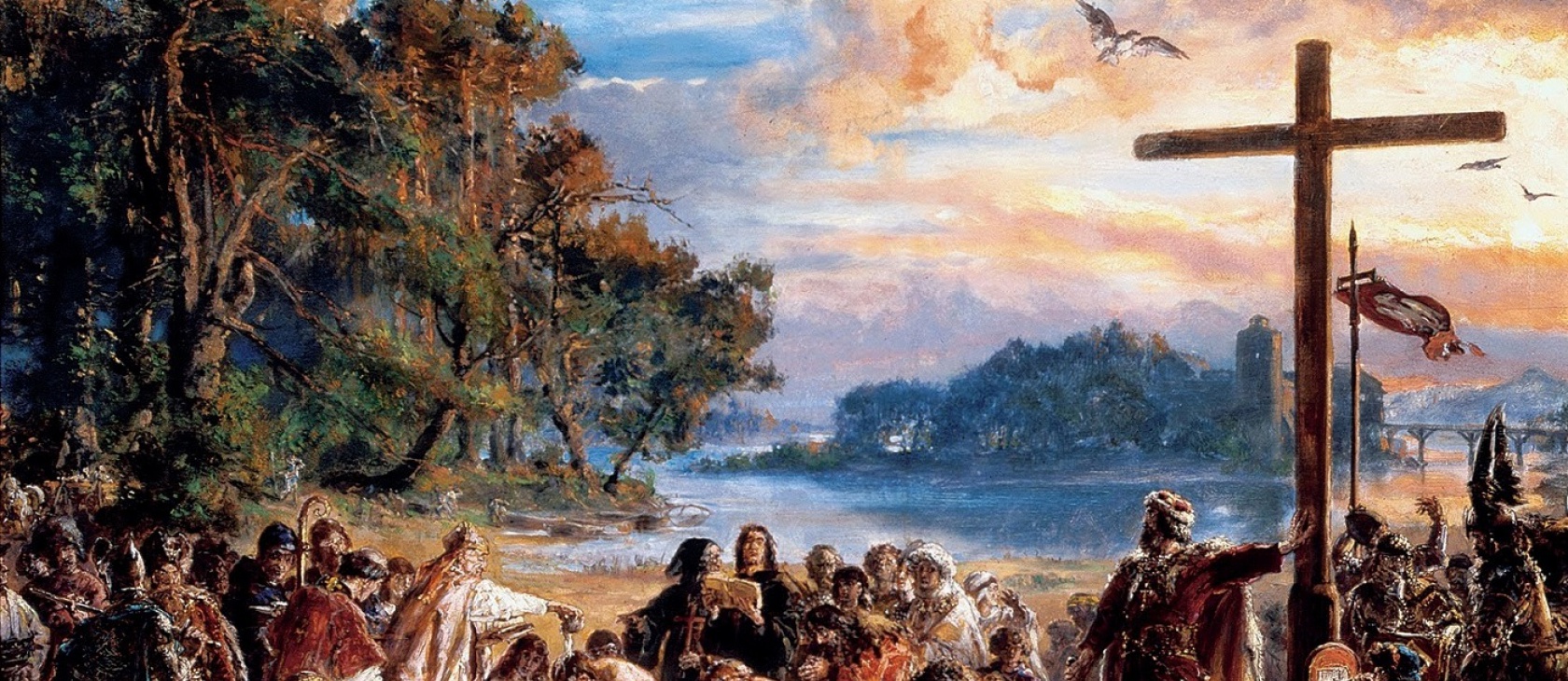The Darkening Age: The Christian Destruction of the Classical World. Catherine Nixey.
London: PanMacmillan, 2017. 305 pages.
H. Carr opens his What is History? by claiming, “When we attempt to answer the question, What is history?, our answer, consciously or unconsciously, reflects our own position in time, and forms part of our answer to the broader question, what view we take of the society in which we live.” Reading a work of history, then, tells the reader just as much about how the historian views his own society as it does about the historical subject under consideration. Catherine Nixey’s The Darkening Age: The Christian Destruction of the Classical World fits Carr’s paradigm. Nixey frames her work as popular revisionist history: “The history and the sufferings of those whom Christianity defeated have not been [told]. This book focuses on them.” The story of monasteries saving Western civilization has been told again and again; Nixey seeks to demonstrate that “before it preserved, the Church destroyed. In a spasm of destruction never seen before - and one that appalled many non-Christians watching - during the fourth and fifth centuries, the Christian Church demolished, vandalized, and melted down a staggering quantity of art.” Nixey does not despise Christianity, but she argues that the traditional narrative portrays Christianity (specifically, Western monasticism) as preserving classical civilization; this narrative is false, she contends, because the Church first destroyed approximately “90 percent” of ancient literature. Nixey makes a significant claim, but fails to write a good history.
 The Darkening Age describes the Late Antique Roman world between two arbitrarily chosen events: the destruction of the temple of Al-Lat in Palmyra in the 380s by Eastern (possibly Nestorian) Christians, and the departure of Damascius from Athens in 529. Between these two events, Nixey conducts a topical survey considering religious changes in the Roman world. She considers martyrdom, belief in demons, the pervasiveness of pagan temples and their replacement by Christian churches, the legal processes privileging Christianity, monastic rituals, and the changing sexual ethos moving from the erotic frescoes of Pompeii to the moralistic sermons of Chrysostom. In her introduction, Nixey rejects a strictly chronological approach, preferring to demonstrate the complexity of the periods through topical analysis. Each chapter begins with an historical narrative told in a journalistic, emotional, sensuous style; Nixey seeks to pull the reader into the sights, sounds, and salacious details of a thriving pagan world. This section then leads into her exposition and analysis contrasting pagans with Christians on a specific topic. By the conclusion of her narrative, Nixey claims that a portion of Justinian’s Code banning all pagans from teaching initiated the Dark Ages. (See p. 237.)
The Darkening Age describes the Late Antique Roman world between two arbitrarily chosen events: the destruction of the temple of Al-Lat in Palmyra in the 380s by Eastern (possibly Nestorian) Christians, and the departure of Damascius from Athens in 529. Between these two events, Nixey conducts a topical survey considering religious changes in the Roman world. She considers martyrdom, belief in demons, the pervasiveness of pagan temples and their replacement by Christian churches, the legal processes privileging Christianity, monastic rituals, and the changing sexual ethos moving from the erotic frescoes of Pompeii to the moralistic sermons of Chrysostom. In her introduction, Nixey rejects a strictly chronological approach, preferring to demonstrate the complexity of the periods through topical analysis. Each chapter begins with an historical narrative told in a journalistic, emotional, sensuous style; Nixey seeks to pull the reader into the sights, sounds, and salacious details of a thriving pagan world. This section then leads into her exposition and analysis contrasting pagans with Christians on a specific topic. By the conclusion of her narrative, Nixey claims that a portion of Justinian’s Code banning all pagans from teaching initiated the Dark Ages. (See p. 237.)
If correct, Nixey’s arguments merit a reevaluation of the relationship between Christianity and Western civilization. Her arguments, however, are not sound. She bases her conclusions on faulty premises which illustrate a lack of awareness in three areas: Christianity, history, and logic.
For a book claiming to offer a new interpretation of the formative years of Christianity’s interactions with Roman civilization, Nixey displays a surprising lack of awareness of the complexity of Christianity’s development. She persistently speaks of “the Church” being the agent behind efforts to censor literature and destroy monuments, and then cites specific bishops (Augustine and Chrysostom for censorship, Shenoute for destruction) who lead people to commit these acts. She speaks of Christianity as if it were a homogeneous organization guided by single-minded leadership. In contrast to this view, her own evidence illustrates instead the role bishops play in faith communities. As the early church developed, the bishop in Late Antiquity gained significant levels of authority, and functioned as the educated, sophisticated representative of his church community to the wider civil and ecclesial world. (For a more detailed account, see K. S. Latourette, A History of Christianity, Vol. 1. San Francisco: HarperSanFrancisco, 1975, 116-118; and The Church from Age to Age: A History. St. Louis: Concordia Publishing House, 2011, 30.) Each bishop governed the churches in his region or city; there was no uniformity in the fourth and fifth centuries. Something like the institutional uniformity Nixey implies developed in medieval Roman Catholicism, but was not part of the Eastern Church on which her narrative focuses. Nixey presents a simplified Christianity which ignores complicating details. She ignores the ecumenical councils. She makes no distinction between orthodox, heterodox, or heretical branches of Christianity, presenting Christians as uniformly and intentionally seeking to erase classical paganism.
The Darkening Age reads like a love letter for paganism.
Nixey presents pagan philosophers as intelligent and academic in contrast to rustic, uneducated Christianity. Throughout her narrative, Christians are presented as opposing learning for moral reasons. In presenting Christianity as such, Nixey ignores the Christian intellectual tradition. She cites Augustine, but only as a bishop; Augustine’s philosophical work is nowhere in this book. She mentions Origen’s castration twice but ignores his philosophical writings. Athanasius, Gregory the Great, Pseudo-Dionysius - the great names of Christian scholarship and philosophy - are absent from her work. Nixey is either ignorant of the complexities of Christianity or is herself willfully omitting details that would complicate her narrative.
Beyond misrepresenting a key element of her study, Nixey misses the mark on the discipline of history itself. I received my historical training from the excellent professors at Hillsdale College. From David Stewart, I learned that change is the only historical constant; therefore, a strong historical question does not ask “did something change?” but rather, “how do people define themselves after change occurs?” From Richard Gamble, I gained a conviction (by way of St. Augustine, Herbert Butterfield, and C.S. Lewis) that the purpose of history is not to judge (read: condemn) the past, but rather to understand it. (See Butterfield, The Whig Interpretation of History. New York: W.W. Norton, 1933, 4.) These professors shaped my love of history, and by both of these criteria Nixey fails to write a work of good history. The Darkening Age reads like a love letter for paganism. Nixey spends paragraphs in each chapter bemoaning the fact that change occurred in the shift from paganism to Christianity as the dominant religion. She mourns the loss of so much classical culture, when a better historical attitude would appreciate the miracle that any of it survived.
She also embraces a simplistic vision of why the classical world came to end. In her view, Christianity is the primary reason that paganism ended. She does not consider economic weakness in the imperial model, changes in the imperial family, weak border security, migrating tribes who complicated Roman political life, or internal contradictions within pagan traditions. Instead of seeing religion as one of many factors, Nixey treats religion as the significant factor causing change. Her work would have been much more interesting if she had considered questions like: Why did Christianity appeal to so many? What was it about this time that lead to so many embracing it? Why did they use governmental force to coerce adherence? Did some governmental officials balk at using force to coerce belief and, if so, why? These would all have made her work much more complete, and reflected a stronger connection between history and the human person. Instead, Nixey settled for a simple narrative which allows for condemnation.
Her book does not increase understanding, but instead reveals the difficulty with which a twenty-first-century secularist examines a faith-filled past.
Where Butterfield urges the historian to understand his subject, Nixey condemns Late Antique Christianity for not practicing twenty-first-century cultural relativism. In her opening description of the destruction of the temple of Al-Lat at Palmyra, Nixey asks, “Did they notice this, the destroyers, as they entered? Were they, even fleetingly, impressed by the sophistication of an empire that could quarry, sculpt, then transport marble over such vast distances?” She expects people who believe that this statue is contributing to the eternal damnation of human souls to pause and admire its artistic value and the economic system that allowed it to exist. Nixey expects the historical actors to possess the historical objectivity she has centuries later; this tone of condemnation continues throughout her book. Nixey does not seek to understand why Christians attacked pagans, destroyed temples, or sought to change sexual mores. She simply condemns them for trying to do so. Her book does not increase understanding, but instead reveals the difficulty with which a twenty-first-century secularist examines a faith-filled past.
The final misunderstanding that plagues The Darkening Age is logical in nature. Nixey correctly identifies one significant spiritual difference between people living in Late Antiquity and our own late modernity: They truly believed in the spiritual realm. As Charles Taylor describes in A Secular Age, the enchanted view of reality permeated the ancient world. Taylor writes, “The enchanted world in this sense is the world of spirits, demons, and moral forces which our ancestors lived in.” Nixey picks up on this and connects it to the Christian opposition to classical statues and temples. I was hopeful when I read her description of Christian belief in demons, but then my hopes fell. Nixey missed the connection; she continues to ask why Christians just can’t live in peace with their pagan neighbors, and calls the Christian opposition to civic worship practices unintelligent. She is missing the implications of pagan truth claims (which contend that anything could be a deity) and Christian truth claims (which hold that there is only one God and human happiness depends upon knowing Him). Nixey portrays a desire for Christians to just add Jesus to the list of pagan deities - after all, the pagans would be fine with that! But she misunderstands that for the men and women of Late Antiquity, these religious beliefs were not just theories to adopt arbitrarily, but truth convictions determining how they lived their lives. Without understanding that, for the men and women of her historical survey, these questions addressed ultimate reality, Nixey cannot obtain the historical consciousness which would allow an accurate reading of history.
History as a discipline suffers from an overabundance of academic writing, which makes it often inaccessible for the general reader. When journalists write history, they sometimes do well. For example, Colin Woodard’s American Nations: A History of the Eleven Rival Regional Cultures of North America is a well-researched, popular rendition of David Hackett-Fischer’s Albion’s Seed: Four British Folkways in America. On other occasions, reading journalistic history only serves to remind one that it takes years to develop the insight that rises to historical understanding. Even then, that understanding must be worded in a clear way and supported with reasoned evidence to convey its insights. The best of historical writing is accessible to educated adults of all disciplines, and it furthers our understanding of the human person; The Darkening Age is not such a work. Instead, it reveals more to us about Catherine Nixey and her understanding of history. The scholars she assembles are uniformly opposed to Christianity, presenting it as a destructive force that ended the “merry, jolly days” of pagan festivity. The prose she uses is filled with judgmental adjectives, indicating that she does not trust readers to draw their conclusion from the evidence; we must be told how to feel about the person she describes. Her book was several years in the making, but it does not reflect a clear understanding of Christianity, the complexities of Late Antiquity, or the nuances of historical craft. While this book is sold under the guise of popular history, treat it instead as an insight into how a secular journalist views Christianity in the year of our Lord 2017.




